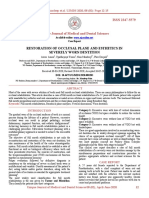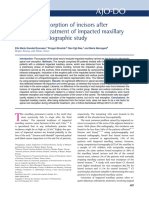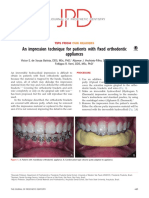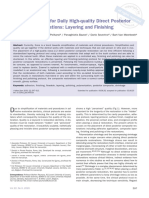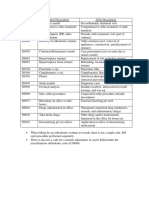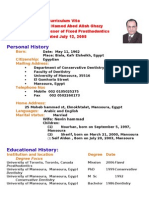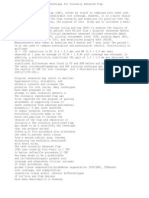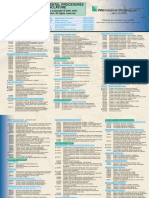Professional Documents
Culture Documents
Knowledge, Attitude and Awareness of CBCT and CT Among Dental Students in Chennai - A Questionnaire Study
Original Title
Copyright
Available Formats
Share this document
Did you find this document useful?
Is this content inappropriate?
Report this DocumentCopyright:
Available Formats
Knowledge, Attitude and Awareness of CBCT and CT Among Dental Students in Chennai - A Questionnaire Study
Copyright:
Available Formats
Volume 7, Issue 12, December – 2022 International Journal of Innovative Science and Research Technology
ISSN No:-2456-2165
Knowledge, Attitude and Awareness of CBCT and
CT Among Dental Students in Chennai –
A Questionnaire Study
Dr.K.Pazhanivel1, Dr.Priya Ramani2 , T.MathiBharathi3, M.S.Mathivadhani4, Meenakshi Arumugam5
1
Senior Lecturer, Department of Oral Medicine & Radiology,
Thaimoogambigai Dental College and Hospital, Chennai, India.
2
Head and Professor, Department of Oral Medicine & Radiology,
Thaimoogambigai Dental College and Hospital, Chennai, India.
3
Junior Resident, Department of Oral Medicine & Radiology,
Thaimoogambigai Dental College and Hospital, Chennai, India.
4
Junior Resident, Department of Oral Medicine & Radiology,
Thaimoogambigai Dental College and Hospital, Chennai, India.
5
Junior Resident, Department of Oral Medicine & Radiology,
Thaimoogambigai Dental College and Hospital, Chennai, India.
Abstract:- dimensional imaging technologies for better and accurate
Aim and Objectives: To assess the Knowledge, Attitude diagnosis.
and Awareness of CBCT and CT among dental students
across Chennai, Tamilnadu. Materials and Methods: A Keywords:- Awareness, CBCT, CT, Dental Radiology,
structured, self-administered online-based cross- Diagnosis, Digital Imaging, Field of View, Radiation
sectional questionnaire study consisting of 15 relevant exposure.
questions were used to assess among 155 dental students
across Chennai, Tamilnadu through Google forms I. INTRODUCTION
distributed on various social media platforms. The
obtained data was analyzed using SPSS version 24.0, and In dentistry, radiographic evaluation is critical for
any P ≤ 0.05 was considered as statistically significant. diagnosis and treatment planning. The inherent drawbacks of
Results: Of all 155 dental students enrolled in the study, two-dimensional imaging is not limited to compressing the
majority of the dental students (86.4%) were familiar three-dimensional (3D) anatomical structures of the
with the term CBCT among which 40% and 35.5% radiographed region into a two-dimensional one (2D) but also
gained more Information about CBCT through lectures includes compromised magnification, image distortion, and
and seminars/CDE/Workshops respectively. 20% of the superimposition, all of which contribute to structural
dental students were unaware of the radiation dose misrepresentation [1, 2]. In such situations, Cone Bean
differences while a very low response rate was obtained Computed Technology (CBCT) or computed tomography
about knowledge on pixels (34.8%), picture element (CT) scanners may be utilized to aid diagnosis, evaluation of
(29%) and different sizes of field of view (FOV) used in disease severity, therapy planning and administration, and
CBCT imaging (45.2%). Though more than half of the appropriate follow-up [3].
dental students (51%) recommend CBCT for various
dental application, 63.2% agree inadequate teaching at Computed Tomography (CT), a high-quality 3D
the undergraduate level on 3D imaging techniques imaging technology that has become widely prevalent in
(CBCT/CT), 78.7% had shown interest to attend courses dental practice since its development in 1972 and is now
pertaining to CBCT in the near future. Conclusion: The recommended before various procedures for visualization of
present study clearly shows lack of knowledge among dental hard tissues as well as osseous structures in the oral
dental students despite adequate awareness and positive cavity including dental pathologies [4, 5]. Though intraoral
attitude on various application aspects of CBCT/CT. This radiographs remains gold standard radiographic diagnostic
observation undoubtedly necessitates the need for tool that aid in detection of dental pathologies, these images
inclusion of new technologies in the oral radiology does not provide complete and superior in-depth details as
curriculum, organizing CDE programs, training courses compared with CBCT/CT that delivers three-dimensional
and workshops to increase the knowledge awareness and diagnosis and treatment planning information with a wide
guide the future dental practitioners to apply three- range of clinical applications. Furthermore, with high quality
images and less radiation doses, introduction of CBCT in
IJISRT22DEC121 www.ijisrt.com 374
Volume 7, Issue 12, December – 2022 International Journal of Innovative Science and Research Technology
ISSN No:-2456-2165
dental and maxillofacial imaging specifically designed to the dental students (51%) reported low radiation dose of
capture the volumetric characteristics of the craniofacial CBCT than CT as the most common reason for its preference
region gives an excellent opportunities to dental surgeons to however 20% were unaware of the radiation dose differences
work accurately in a wider applications ranging from between them while a very low response rate was obtained
assessment of impacted third molar in proximity to vital about knowledge on matrix individual blocks in CT as 34.8%
structures, analysis of jaws for implant placement, evaluation considered it as Pixel and 29% selected as picture element.
of dento-facial region for and /or during orthodontic
treatment, Temporo-mandibular joint disorders, On assessment on attitude and practice awareness
dentoalveolar trauma, pulp and periapical pathologies towards CBCT against CT in dentistry, majority of the dental
including cysts, tumors, and abscess, detection and students prefer CBCT for 3D imaging of head and neck
characterization of the bony aspects of periodontal disease, region (67.1%), for locating the impacted maxillary canine
and endodontic applications [6, 7, 8, 9]. (60%), while 40.7% recommend CBCT for detecting the
morphology of root canal, and 27.1% for detection of number
The usage of CT in dental practice was largely affected of canals in endodontic practice (Figure 3). One third of the
by its high cost, increased radiation exposure and limited dental students (34.2%) reported pleomorphic adenoma cases
accessibility whereas CBCT imaging is less expensive, and 27.1% responded internal disc arrangement cases are
require minimal space than CT scanners, produces rapid high absolute contraindication of CBCT in diagnostic imaging
quality images at short scanning time with beam limited to among which 36.1% considered in CT, patient will be in
head and neck region, reduced magnitude of irradiated areas, supine position; while in CBCT, and patient will be either
decreased radiation doses and also possess multivariate standing or sitting position as the major technical difference
display modes to enhance ideal imaging despite poor soft exception between the two imaging procedures (Figure 4).
tissue contrast, beam hardening artefacts and scatter artefacts
from previous restorations and metallic crowns [10, 11]. Majority of the dental students (63.2%) agree
Thus, clinicians and dental surgeons should use CBCT only inadequate teaching at the undergraduate level on 3D imaging
when there is need and it cannot be taken adequately by lower techniques (CBCT/CT) and lack of participation (72.9%
dose conventional dental radiography or alternate imaging never attended) in any CBCT related courses in the past or
modalities [12, 13]. during the course of their dental education training as reasons
for lack of sufficient knowledge (Figure 5) . It was also
II. MATERIALS AND METHODS illustrated that more than half of the dental students (51.6%)
recommended CBCT should be a part of dental curriculum
A questionnaire-based cross-sectional assessment and education in final year and 30.3% recommended CBCT
survey was carried out amongst the dental students (Final as a part of third year (BDS) dental curriculum to gain
years, Interns, PGs) across Chennai, Tamilnadu to assess their adequate theoretical knowledge (Figure 6). Lack of
Knowledge, Attitude and Awareness of CBCT and CT. After awareness (34.8%) and lack of availability (34.2%) as a key
obtaining the Ethical clearance, the prerequisite information factor for not using CBCT in their dental practice, among
was collected and 15 relevant questions were prepared using which 78.7% are willing to practice and had shown interest
available evidence-based literature about the present study. to attend courses pertaining to CBCT in the near future
The self-administered questionnaire was distributed among (Figure 7).
undergraduate and postgraduate dental students with few
selected responses to specific questions along with close-
ended questions. Since this study was carried out during the SOURCE OF KNOWLEDGE ABOUT
COVID-19 Pandemic situation, online Google forms were CBCT
generated and circulated through various social media
platforms.
III. RESULTS 7% Seminars/
workshops/
On analysis of the given data, it was observed that the 17% 36% CDE
majority of the dental students were Final year undergraduate
dental students (58.7%) followed by CRRIs/Internship Lectures by
faculty
students (32.2%) and the least being postgraduate dental
students (9.1%) respectively. Of all the 155 dental students
enrolled in the present study, majority of the dental students 40%
(86.4%) were familiar with the term CBCT that stands for
Cone Beam Computed tomography . On further evaluation of
knowledge awareness towards CBCT/CT it was observed
40% and 35.5% gained more knowledge/Information about Fig 1 Pie diagram showing the source of knowledge about
CBCT through lectures and by attending CBCT
seminars/CDE/Workshops respectively (Figure 1) among
which 67.1% prefer CBCT and only 17.4% opted CT for 3D
imaging of head and neck region (Figure 2). About half of
IJISRT22DEC121 www.ijisrt.com 375
Volume 7, Issue 12, December – 2022 International Journal of Innovative Science and Research Technology
ISSN No:-2456-2165
3D Imaging of Head and Neck Reason for not using CBCT in routine
practice
3%
12% 18%
CT 12% lack of awareness
CBCT 35% lack of knowledge
MRI
lack of availability
34%
ULTRASOUND
tough to perform
67% 19%
Fig 2 pie diagram showing the recommended 3D imaging Fig 5 pie diagram showing the reason for not using CBCT in
techniques for head and neck routine dental practice
CBCT IN DENTAL EDUCATION
CBCT in Endodontics
6%
12% 1st year
19% detection of
27% canals 2nd year
detection of 52% 3rd year
13%
morphology of
30% 4th year
canals
tooth vitality
41% detection
Fig 6 pie diagram showing the dental education in CBCT
Fig 3 pie diagram showing the application of CBCT in acquired in
endodontics
120.00%
DIFFERENCE BETWEEN CBCT and CT 100.00%
21.30%
Except 80.00% 36.80% 45.20%
60.00% 72.90%
fan shape cone beam
shaped 40.00% 78.70%
63.20% 54.80%
21% supine and sitting 20.00% NO
22% 27.10%
position 0.00%
YES
FOV
21% Detector area and line
36%
Fig 4 pie diagram showing the difference between CBCT Fig 7 bar graph showing the yes or no responses
and CT except
IJISRT22DEC121 www.ijisrt.com 376
Volume 7, Issue 12, December – 2022 International Journal of Innovative Science and Research Technology
ISSN No:-2456-2165
IV. DISCUSSION relationship of image with the exposure factors [9]. A very
low response rate was obtained about knowledge on matrix
Cone beam computed tomography (CBCT) has largely individual blocks in CT as 34.8% considered it as Pixel and
replaced CT and emerged as a key tool in 3- dimensional (3D) 29% selected as picture element. Similar low responses
modality of choice in dental imaging and diagnosis. Though (45.2%) were also reported on knowledge towards different
it has developed as an innovation in dental imaging, sizes of field of view (FOV) used to take CBCT scan which
guidelines based on studies with low levels of evidence was inconsistent with study by Nagarale R et al [6], Al-
demanded additional research on CBCT effectiveness and its Noamam RF et al [10].
clinical implications as majority of previous studies focused
largely on digital methods and radiation protection protocols. Balabaskaran et al [11], Sathawane R et al [12] in their
Very few studies evaluated knowledge, attitude and respective studies showed majority of the dental students
awareness among dental students towards their clinical refer CBCT for various dental applications similar to our
application had shown clear lack of knowledge, awareness study where 67.1% opted 3D imaging of head and neck
and hesitancy towards its use and diagnostic importance in region, for locating the impacted maxillary canine (60%),
routine dental practice [1-5]. This necessitated the inclusion while 40.7% recommend CBCT for detecting the
of new technologies in the oral radiology curriculum to guide morphology of root canal, and 27.1% for detection of number
the future dental practitioners and apply three-dimensional of canals in endodontic practice. Studies by Kamburoglu K et
imaging technologies for diagnosis and treatment planning. al [2], Gunasekaran S et al [3] and Shetty SR et al [13] were
The present study used modified questionnaire to assess the in agreement with our study results where dental students
knowledge and awareness on various application aspects of agree lack of awareness (34.8%) and lack of availability
CBCT and CT and also to establish the importance of dental (34.2%) as a key factor for not using CBCT in their dental
students' attitudes towards new technologies among practice. It was evident that 78.7% are willing to practice and
undergraduate and post-graduates across Chennai, had shown interest to attend courses pertaining to CBCT in
Tamilnadu. the near future comparatively lower than observations by
Gunasekaran S et al [3] and Shetty R et al [13].
In the present study majority of the dental students
(86.4%) were familiar with the term CBCT among which V. CONCLUSION
40% and 35.5% gained more knowledge/Information about
CBCT through lectures and by attending The present study clearly shows lack of knowledge
seminars/CDE/Workshops (75.5%) respectively which was among dental students despite adequate awareness on various
consistent with the studies conducted by Mahabob MN et al application aspects of CBCT in comparable to CT. More than
[1], Kamburoglu K et al [2] and Gunasekaran S et al [3] half of the dental students had shown interest to attend
among which 67.1% prefer CBCT and only 17.4% opted CT courses pertaining to CBCT signifies positive attitude
for 3D imaging of head and neck region which was relatively towards implementing CBCT in routine dental practice. This
higher than other studies carried out by Gunasekaran S et al necessitated the inclusion of new technologies in the oral
[3], Lavanya R et al [4] and Almohiy H et al [5]. More than radiology curriculum, organizing continuing dental education
half of the dental students (51.6%) recommended CBCT programs, training courses and workshops to increase their
should be a part of dental curriculum and education in final knowledge awareness and guide the future dental
year and 30.3% recommended CBCT as a part of third year practitioners to apply three-dimensional imaging
(BDS) dental curriculum to gain adequate theoretical technologies for better and accurate diagnosis and
knowledge which was similar to the results by Kamburoglu management.
K et al [2], Gunasekaran S et al [3], and Lavanya R et al [4].
Majority of dental students owing to the fact that inadequate REFERENCES
teaching at the undergraduate level on 3D imaging techniques
CBCT/CT (63.2%) and lack of participation (72.9% never [1]. Mahabob MN, Ali RW, Albaraih AJ, Fathima AM.
attended) in any CBCT related courses in the past or during Knowledge and Attitude towards CBCT among Dental
the course of their dental education training as significant Students, Interns and GDPS from College of Dentistry
contributors for lack of sufficient knowledge. in Eastern Province of KSA-A Cross-Sectional Study.
Annals of the Romanian Society for Cell Biology. 2021
Nearly half of the dental students (51%) reported low May 2:525-39.
radiation dose of CBCT than CT as the most common reason [2]. Kamburoğlu K, Kurşun Ş, Akarslan ZZ. Dental
for its preference however 20% were unaware of the radiation students' knowledge and attitudes towards cone beam
dose differences between them comparatively higher than computed tomography in Turkey. Dentomaxillofacial
previous studies by Kamburoglu K et al [2], Nagarale R et al Radiology. 2011 Oct; 40(7):439-43.
[6]. Although CBCT has less radiation dose correlated to the [3]. Gunasekaran S, Mahabob N, Elangovan S, Jaishankar
conventional CT, studies by Silva MA et al [7], Grunheld T S. Knowledge and attitude towards CBCT among dental
et al [8] reported that the effective dose of CBCT is several to students in Western Tamilnadu-A cross sectional study.
hundreds of times more than the effective dose from plain World J Pharm Med Res. 2018; 4:230-3.
two-dimensional dental imaging techniques. Li G et al stated [4]. Lavanya R, Babu DG, Waghray S, Chaitanya NC,
that greater the field of view (FOV), higher the spatial Mamatha B, Nithika M. A questionnaire cross-sectional
resolution with higher effective dose suggesting a direct
IJISRT22DEC121 www.ijisrt.com 377
Volume 7, Issue 12, December – 2022 International Journal of Innovative Science and Research Technology
ISSN No:-2456-2165
study on application of CBCT in dental postgraduate
students. Polish journal of radiology. 2016; 81:181.
[5]. Almohiy H, Alshahrani I. Cone beam computed
tomography (CBCT) in dentistry-
students_ampersandsign# 39; and
interns_ampersandsign# 39; perspective in Abha, Saudi
Arabia. Annals of Tropical Medicine and Public Health.
2019 Sep; 22:01-12.
[6]. Nagarale R, Todkar M, Yunus S, Shaikh MS, Bharmal
M, Dabhiya S. Assessment of knowledge, attitude and
awareness regarding cone beam computed tomography
among dental graduates in Pune city, India.
[7]. Silva MA, Wolf U, Heinicke F, Bumann A, Visser H,
Hirsch E. Cone-beam computed tomography for routine
orthodontic treatment planning: A radiation dose
evaluation. Am J Orthod Dentofacial Orthop. 2008;133:
640.e1-5.
[8]. Grünheid T, Kolbeck Schieck JR, Pliska BT, Ahmad M,
Larson BE. Dosimetry of a cone-beam computed
tomography machine compared with a digital x-ray
machine in orthodontic imaging. Am J Orthod
Dentofacial Orthop. 2012; 141:436- 43.
[9]. Li G. Patient radiation dose and protection from cone-
beam computed tomography. Imaging Science in
Dentistry. 2013; 43(2): 63-9.
[10]. Al Noaman RF, El Khateeb SM. Knowledge and
attitude of cone beam CT–a questionnaire based study
among Saudi dental students. J Adv Med Med Res.
2017; 2:1-5.
[11]. Balabaskaran K. Srinivasan L.A. Awareness and
Attitude among Dental Professional towards CBCT.
IOSR Journal of Dental and Medical Sciences, 2013;
10(5); 55-59.
[12]. Sathawane R, Bhakte K, Chandak R, Lanjekar A, Bagde
L. Awareness, Knowledge and Attitude of Dental
Students and General Dental Practitioners of Nagpur
towards CBCT: A Questionnaire Based Analytical
study. Int J Res Rev. 2020; 7(6):398-403.
[13]. Shetty SR, Castelino RL, Babu SG, Prasanna, Laxmana
AR, Roopashri K. Knowledge and attitude of dentists
towards cone beam computed tomography in
Mangalore: A questionnaire survey. Austin Journal of
Radiology. 2015; 2(2):10-16.
IJISRT22DEC121 www.ijisrt.com 378
You might also like
- ECU Designing and Testing Using NI ProductsDocument6 pagesECU Designing and Testing Using NI ProductsOmar Eladel MahmoudNo ratings yet
- 005-012 Fuel Injection Pumps, In-Line: InstallDocument14 pages005-012 Fuel Injection Pumps, In-Line: InstallMuhammad Ishfaq100% (3)
- CAS Craniomaxillofacial Surgery PlanningDocument18 pagesCAS Craniomaxillofacial Surgery Planninghasan nazzalNo ratings yet
- Slit LampDocument20 pagesSlit LampTricia Gladys SoRiano80% (5)
- 8 - Clinical Outcome in Periradicular Surgery Effect of Patient - and Tooth-Related Factors - A Multicenter StudyDocument8 pages8 - Clinical Outcome in Periradicular Surgery Effect of Patient - and Tooth-Related Factors - A Multicenter StudykochikaghochiNo ratings yet
- Space AnalysisDocument43 pagesSpace AnalysismarieNo ratings yet
- Bone Ring 3Document4 pagesBone Ring 3Pradusha RevuruNo ratings yet
- Dental Assistants in OrthodonticsDocument2 pagesDental Assistants in Orthodonticsmaryam fatimaNo ratings yet
- Protocol Clinic Proteze BPS IvoclarDocument38 pagesProtocol Clinic Proteze BPS IvoclarOvidiu SchifirnetNo ratings yet
- Healers Versus Stealers: How to Outsmart the Thief in Your Dental PracticeFrom EverandHealers Versus Stealers: How to Outsmart the Thief in Your Dental PracticeNo ratings yet
- Guía Iadt 2020Document46 pagesGuía Iadt 2020Johanna Giliberto RodríguezNo ratings yet
- Purchase OrderDocument2 pagesPurchase OrderNicole LomasangNo ratings yet
- Clinical Practice Guidelines Approved 2021 HODDocument57 pagesClinical Practice Guidelines Approved 2021 HODNovaira WaseemNo ratings yet
- Guidelines - For - Clinical - Photography - 2015 Rev PDFDocument4 pagesGuidelines - For - Clinical - Photography - 2015 Rev PDFGualterio PoloNo ratings yet
- Artículo 2Document10 pagesArtículo 2jhon valdiviezoNo ratings yet
- Advantages and Disadvantages of Social MediaDocument2 pagesAdvantages and Disadvantages of Social MediaCeleste GalvanNo ratings yet
- Guide to Cross-Subject Area ReportsDocument19 pagesGuide to Cross-Subject Area Reportssatyanarayana NVSNo ratings yet
- RAN KPI MonitorDocument8 pagesRAN KPI MonitorOmer WaqarNo ratings yet
- HypnosisDocument2 pagesHypnosisEsteban MendozaNo ratings yet
- Comparative Analysis of Elastomeric Die Materials For Semidirect Composite RestorationsDocument12 pagesComparative Analysis of Elastomeric Die Materials For Semidirect Composite Restorationsjose figueroa100% (1)
- Management of Impacted Third MolarsDocument30 pagesManagement of Impacted Third Molarscatalin petreNo ratings yet
- An Ounce of Prevention Is Worth A Pound of Cure: Ergonomics in Dental PracticeDocument6 pagesAn Ounce of Prevention Is Worth A Pound of Cure: Ergonomics in Dental Practicetri wahyuniNo ratings yet
- Periodontics & Restorative: MaintenanceDocument10 pagesPeriodontics & Restorative: Maintenancechakri1089No ratings yet
- Full Mouth Adhesive Rehabilitation. The Three Stpe Techinique Part 2Document30 pagesFull Mouth Adhesive Rehabilitation. The Three Stpe Techinique Part 2Diego CesarNo ratings yet
- V2 - PLANETS of ORTHODONTICS - Volume II - Diagnosis and Treatment PlanningDocument290 pagesV2 - PLANETS of ORTHODONTICS - Volume II - Diagnosis and Treatment PlanningPhanQuangHuyNo ratings yet
- Leal Minimal Intervention Review BDJ 2014 21611623-627Document6 pagesLeal Minimal Intervention Review BDJ 2014 21611623-627keperawatangigi D4No ratings yet
- Clinical Photography: Clarification of Common Problems Facing The Wound PhotographerDocument3 pagesClinical Photography: Clarification of Common Problems Facing The Wound Photographersyahroel778583No ratings yet
- Vailati 2Document22 pagesVailati 2Linda Garcia PNo ratings yet
- IAPD20 Virtual Abstract Book CompressedDocument991 pagesIAPD20 Virtual Abstract Book CompressedAnonymous NqTjEcNo ratings yet
- Restoration of Occlusal Plane and Esthetics in Severely Worn DentitionDocument4 pagesRestoration of Occlusal Plane and Esthetics in Severely Worn DentitionUJ CommunicationNo ratings yet
- Textbook of Removable ProsthodonticsDocument249 pagesTextbook of Removable ProsthodonticsskcaswuiNo ratings yet
- Pediatric Dentistry and Preventive CareDocument7 pagesPediatric Dentistry and Preventive CareHARSH KUMARNo ratings yet
- Anestesicos Locales (Dental Clinics) PDFDocument27 pagesAnestesicos Locales (Dental Clinics) PDFJuan Jose Stuven RodriguezNo ratings yet
- CDT 2017 - Code On Dental Proc - Nomenclature OnlineDocument20 pagesCDT 2017 - Code On Dental Proc - Nomenclature OnlineErwin FelipeNo ratings yet
- Apical Root Resorption of Incisors After Orthodontic Treatment of Impacted Maxillary Canines, Radiographic StudyDocument9 pagesApical Root Resorption of Incisors After Orthodontic Treatment of Impacted Maxillary Canines, Radiographic StudyJose CollazosNo ratings yet
- Dental FluorosisDocument8 pagesDental Fluorosiskuantumonline100% (1)
- Save the natural tooth or place an implant ? A Periodontal decisional criteria to perform a correct therapy. Ricci, Ricci & Ricci. The International Journal of Periodontics & Restorative Dentistry, 2011; 31, 29-37. .pdfDocument10 pagesSave the natural tooth or place an implant ? A Periodontal decisional criteria to perform a correct therapy. Ricci, Ricci & Ricci. The International Journal of Periodontics & Restorative Dentistry, 2011; 31, 29-37. .pdfanonimoNo ratings yet
- Evidence Based Retention Where Are We Now 2017 Seminars in OrthodonticsDocument8 pagesEvidence Based Retention Where Are We Now 2017 Seminars in Orthodonticsdruzair007No ratings yet
- Photographic-Assisted Diagnosis and Treatment PlanningDocument17 pagesPhotographic-Assisted Diagnosis and Treatment Planningroman7dbNo ratings yet
- Smile Analysis What To MeasureDocument6 pagesSmile Analysis What To MeasureAli RazaNo ratings yet
- Reducing The Risk of Failure Incomplete Denture PatientsDocument8 pagesReducing The Risk of Failure Incomplete Denture PatientsHisyam IshakNo ratings yet
- European Board OF Orthodontists: H.S. Duterloo P-G. PlanchéDocument66 pagesEuropean Board OF Orthodontists: H.S. Duterloo P-G. PlanchéElla GolikNo ratings yet
- 3shape PCDocument9 pages3shape PCSoLiTaRiO33No ratings yet
- An Impression Technique For Patients With Fixed Orthodontic AppliancesDocument2 pagesAn Impression Technique For Patients With Fixed Orthodontic Appliancesmoji_puiNo ratings yet
- GRUPO 3 - 2021c - Effective Protocol For Daily High-Quality Direct Posterior Composite Restorations - Layering and FinishingDocument18 pagesGRUPO 3 - 2021c - Effective Protocol For Daily High-Quality Direct Posterior Composite Restorations - Layering and FinishingPaulina LobosNo ratings yet
- Endo LaseDocument5 pagesEndo LaseAlex PaunNo ratings yet
- Orthodontic Update - April 2020 PDFDocument54 pagesOrthodontic Update - April 2020 PDFMaria TzagarakiNo ratings yet
- Shortcuts in Esthetic DentistryDocument1 pageShortcuts in Esthetic DentistryGabriel Lazar100% (1)
- ADA Ortho CodesDocument1 pageADA Ortho CodesAmerican Aesthetic MCNo ratings yet
- 3M - 93C HallTechGuide2191110 PDFDocument21 pages3M - 93C HallTechGuide2191110 PDFDuvan CastilloNo ratings yet
- Cephx Invisalign PDFDocument9 pagesCephx Invisalign PDFVieussens JoffreyNo ratings yet
- Vceph6.0 Manual Viet OsstemDocument151 pagesVceph6.0 Manual Viet OsstemThang ChuNo ratings yet
- Diagnosis & Pt. AssessmentDocument58 pagesDiagnosis & Pt. Assessmentmahmoud wesamNo ratings yet
- Excellence in OrthodonticsDocument8 pagesExcellence in OrthodonticsAkram AlsharaeeNo ratings yet
- Removable Partial DentureDocument7 pagesRemovable Partial DentureAinul MardiahNo ratings yet
- MY NEW CV CompleteDocument8 pagesMY NEW CV CompleteMohamed Hamed GhazyNo ratings yet
- The Real Truth About CRDocument11 pagesThe Real Truth About CRAhmed HamzaNo ratings yet
- 0 Orthotics Bhargava Et Al 2023Document11 pages0 Orthotics Bhargava Et Al 2023David MonroyNo ratings yet
- Mandibular Advancement Device & Rapid Maxillary ExpansionDocument35 pagesMandibular Advancement Device & Rapid Maxillary Expansion이상하No ratings yet
- Evaluating Pain, Fear, Anxiety or Stress/distress Using Children's Drawings in Paediatric Dentistry: A Scoping ReviewDocument24 pagesEvaluating Pain, Fear, Anxiety or Stress/distress Using Children's Drawings in Paediatric Dentistry: A Scoping ReviewLuciana SanglardNo ratings yet
- AJODO-2013 Angelieri 144 5 759Document11 pagesAJODO-2013 Angelieri 144 5 759osama-alali100% (1)
- Existing Restoration - Clinical Status: Secondary Caries Marginal Integrity Biomechanical FormDocument47 pagesExisting Restoration - Clinical Status: Secondary Caries Marginal Integrity Biomechanical FormDaniel WangNo ratings yet
- Sling and Tag Suturing Technique For Coronally Advanced FlapDocument7 pagesSling and Tag Suturing Technique For Coronally Advanced FlapFerdinan Pasaribu0% (1)
- Ada CodesDocument4 pagesAda CodestedyNo ratings yet
- Buchel, 2014 (A 4-Week Clinical Comparison of An Oscillating-Rotating Power Brush Versus A Marketed Sonic Brush in Reducing Dental Plaque) PDFDocument5 pagesBuchel, 2014 (A 4-Week Clinical Comparison of An Oscillating-Rotating Power Brush Versus A Marketed Sonic Brush in Reducing Dental Plaque) PDFAdam SweidanNo ratings yet
- Magnification in EndodonticsDocument15 pagesMagnification in EndodonticsmoatazendoNo ratings yet
- Essential Tissue Healing of the Face and NeckFrom EverandEssential Tissue Healing of the Face and NeckRating: 5 out of 5 stars5/5 (2)
- Securing Document Exchange with Blockchain Technology: A New Paradigm for Information SharingDocument4 pagesSecuring Document Exchange with Blockchain Technology: A New Paradigm for Information SharingInternational Journal of Innovative Science and Research TechnologyNo ratings yet
- The Effect of Time Variables as Predictors of Senior Secondary School Students' Mathematical Performance Department of Mathematics Education Freetown PolytechnicDocument7 pagesThe Effect of Time Variables as Predictors of Senior Secondary School Students' Mathematical Performance Department of Mathematics Education Freetown PolytechnicInternational Journal of Innovative Science and Research TechnologyNo ratings yet
- Perceived Impact of Active Pedagogy in Medical Students' Learning at the Faculty of Medicine and Pharmacy of CasablancaDocument5 pagesPerceived Impact of Active Pedagogy in Medical Students' Learning at the Faculty of Medicine and Pharmacy of CasablancaInternational Journal of Innovative Science and Research TechnologyNo ratings yet
- Formation of New Technology in Automated Highway System in Peripheral HighwayDocument6 pagesFormation of New Technology in Automated Highway System in Peripheral HighwayInternational Journal of Innovative Science and Research TechnologyNo ratings yet
- Supply Chain 5.0: A Comprehensive Literature Review on Implications, Applications and ChallengesDocument11 pagesSupply Chain 5.0: A Comprehensive Literature Review on Implications, Applications and ChallengesInternational Journal of Innovative Science and Research TechnologyNo ratings yet
- Exploring the Clinical Characteristics, Chromosomal Analysis, and Emotional and Social Considerations in Parents of Children with Down SyndromeDocument8 pagesExploring the Clinical Characteristics, Chromosomal Analysis, and Emotional and Social Considerations in Parents of Children with Down SyndromeInternational Journal of Innovative Science and Research TechnologyNo ratings yet
- Intelligent Engines: Revolutionizing Manufacturing and Supply Chains with AIDocument14 pagesIntelligent Engines: Revolutionizing Manufacturing and Supply Chains with AIInternational Journal of Innovative Science and Research TechnologyNo ratings yet
- The Making of Self-Disposing Contactless Motion-Activated Trash Bin Using Ultrasonic SensorsDocument7 pagesThe Making of Self-Disposing Contactless Motion-Activated Trash Bin Using Ultrasonic SensorsInternational Journal of Innovative Science and Research TechnologyNo ratings yet
- Beyond Shelters: A Gendered Approach to Disaster Preparedness and Resilience in Urban CentersDocument6 pagesBeyond Shelters: A Gendered Approach to Disaster Preparedness and Resilience in Urban CentersInternational Journal of Innovative Science and Research TechnologyNo ratings yet
- Enhancing the Strength of Concrete by Using Human Hairs as a FiberDocument3 pagesEnhancing the Strength of Concrete by Using Human Hairs as a FiberInternational Journal of Innovative Science and Research TechnologyNo ratings yet
- Natural Peel-Off Mask Formulation and EvaluationDocument6 pagesNatural Peel-Off Mask Formulation and EvaluationInternational Journal of Innovative Science and Research TechnologyNo ratings yet
- Teachers' Perceptions about Distributed Leadership Practices in South Asia: A Case Study on Academic Activities in Government Colleges of BangladeshDocument7 pagesTeachers' Perceptions about Distributed Leadership Practices in South Asia: A Case Study on Academic Activities in Government Colleges of BangladeshInternational Journal of Innovative Science and Research TechnologyNo ratings yet
- Handling Disruptive Behaviors of Students in San Jose National High SchoolDocument5 pagesHandling Disruptive Behaviors of Students in San Jose National High SchoolInternational Journal of Innovative Science and Research TechnologyNo ratings yet
- Safety, Analgesic, and Anti-Inflammatory Effects of Aqueous and Methanolic Leaf Extracts of Hypericum revolutum subsp. kenienseDocument11 pagesSafety, Analgesic, and Anti-Inflammatory Effects of Aqueous and Methanolic Leaf Extracts of Hypericum revolutum subsp. kenienseInternational Journal of Innovative Science and Research TechnologyNo ratings yet
- REDLINE– An Application on Blood ManagementDocument5 pagesREDLINE– An Application on Blood ManagementInternational Journal of Innovative Science and Research TechnologyNo ratings yet
- Placement Application for Department of Commerce with Computer Applications (Navigator)Document7 pagesPlacement Application for Department of Commerce with Computer Applications (Navigator)International Journal of Innovative Science and Research TechnologyNo ratings yet
- Optimization of Process Parameters for Turning Operation on D3 Die SteelDocument4 pagesOptimization of Process Parameters for Turning Operation on D3 Die SteelInternational Journal of Innovative Science and Research TechnologyNo ratings yet
- Advancing Opthalmic Diagnostics: U-Net for Retinal Blood Vessel SegmentationDocument8 pagesAdvancing Opthalmic Diagnostics: U-Net for Retinal Blood Vessel SegmentationInternational Journal of Innovative Science and Research TechnologyNo ratings yet
- Adoption of International Public Sector Accounting Standards and Quality of Financial Reporting in National Government Agricultural Sector Entities, KenyaDocument12 pagesAdoption of International Public Sector Accounting Standards and Quality of Financial Reporting in National Government Agricultural Sector Entities, KenyaInternational Journal of Innovative Science and Research TechnologyNo ratings yet
- A Curious Case of QuadriplegiaDocument4 pagesA Curious Case of QuadriplegiaInternational Journal of Innovative Science and Research TechnologyNo ratings yet
- A Knowledg Graph Model for e-GovernmentDocument5 pagesA Knowledg Graph Model for e-GovernmentInternational Journal of Innovative Science and Research TechnologyNo ratings yet
- Machine Learning and Big Data Analytics for Precision Cardiac RiskStratification and Heart DiseasesDocument6 pagesMachine Learning and Big Data Analytics for Precision Cardiac RiskStratification and Heart DiseasesInternational Journal of Innovative Science and Research TechnologyNo ratings yet
- Forensic Evidence Management Using Blockchain TechnologyDocument6 pagesForensic Evidence Management Using Blockchain TechnologyInternational Journal of Innovative Science and Research TechnologyNo ratings yet
- Analysis of Financial Ratios that Relate to Market Value of Listed Companies that have Announced the Results of their Sustainable Stock Assessment, SET ESG Ratings 2023Document10 pagesAnalysis of Financial Ratios that Relate to Market Value of Listed Companies that have Announced the Results of their Sustainable Stock Assessment, SET ESG Ratings 2023International Journal of Innovative Science and Research TechnologyNo ratings yet
- Pdf to Voice by Using Deep LearningDocument5 pagesPdf to Voice by Using Deep LearningInternational Journal of Innovative Science and Research TechnologyNo ratings yet
- Improvement Functional Capacity In Adult After Percutaneous ASD ClosureDocument7 pagesImprovement Functional Capacity In Adult After Percutaneous ASD ClosureInternational Journal of Innovative Science and Research TechnologyNo ratings yet
- Fruit of the Pomegranate (Punica granatum) Plant: Nutrients, Phytochemical Composition and Antioxidant Activity of Fresh and Dried FruitsDocument6 pagesFruit of the Pomegranate (Punica granatum) Plant: Nutrients, Phytochemical Composition and Antioxidant Activity of Fresh and Dried FruitsInternational Journal of Innovative Science and Research TechnologyNo ratings yet
- Food habits and food inflation in the US and India; An experience in Covid-19 pandemicDocument3 pagesFood habits and food inflation in the US and India; An experience in Covid-19 pandemicInternational Journal of Innovative Science and Research TechnologyNo ratings yet
- Severe Residual Pulmonary Stenosis after Surgical Repair of Tetralogy of Fallot: What’s Our Next Strategy?Document11 pagesSevere Residual Pulmonary Stenosis after Surgical Repair of Tetralogy of Fallot: What’s Our Next Strategy?International Journal of Innovative Science and Research TechnologyNo ratings yet
- Scrolls, Likes, and Filters: The New Age Factor Causing Body Image IssuesDocument6 pagesScrolls, Likes, and Filters: The New Age Factor Causing Body Image IssuesInternational Journal of Innovative Science and Research TechnologyNo ratings yet
- Decision Tree Classifier On Private DataDocument8 pagesDecision Tree Classifier On Private DataBianca RodriguesNo ratings yet
- ZF 4hp14 - 2Document9 pagesZF 4hp14 - 2Miguel BentoNo ratings yet
- Pointer C++ (UAMD)Document6 pagesPointer C++ (UAMD)SaiDj DulevicNo ratings yet
- Duration of LTMDocument3 pagesDuration of LTMsamueldaNo ratings yet
- Reflection 4Document7 pagesReflection 4danilo miguelNo ratings yet
- Jigsaw IIDocument1 pageJigsaw IIapi-239373469No ratings yet
- Spatial data analysis with GIS (DEMDocument11 pagesSpatial data analysis with GIS (DEMAleem MuhammadNo ratings yet
- Factors Affecting Drying Rates and MechanismsDocument4 pagesFactors Affecting Drying Rates and MechanismsMahesh VoraNo ratings yet
- Paper Velocity String SPE-30197-PADocument4 pagesPaper Velocity String SPE-30197-PAPablo RaffinNo ratings yet
- How To Review A Book in Up To 5,000 Words: First StepsDocument3 pagesHow To Review A Book in Up To 5,000 Words: First StepsAnnaNo ratings yet
- Anagrams in Enhancing The Learner's Vocabolary in Filipino Language Using WordwallDocument19 pagesAnagrams in Enhancing The Learner's Vocabolary in Filipino Language Using WordwallJARYL PILLAZARNo ratings yet
- Product PlanningDocument23 pagesProduct PlanningGrechen CabusaoNo ratings yet
- Worksheet Chapter 50 Introduction To Ecology The Scope of EcologyDocument2 pagesWorksheet Chapter 50 Introduction To Ecology The Scope of EcologyFernando CastilloNo ratings yet
- KTO12 Curriculum ExplainedDocument24 pagesKTO12 Curriculum ExplainedErnesto ViilavertNo ratings yet
- Technical Specifications For Construction Tower Support 113-Shc-Ta-001 and 113-Sch-Ta-002 at The Coke Handling SystemDocument12 pagesTechnical Specifications For Construction Tower Support 113-Shc-Ta-001 and 113-Sch-Ta-002 at The Coke Handling SystemAna RojasNo ratings yet
- Rosalind FranklinDocument1 pageRosalind FranklinMichael SmithNo ratings yet
- Spatial Personality For Human Space InteractionDocument10 pagesSpatial Personality For Human Space Interactionavijitsaha bornoNo ratings yet
- Legal Opinion WritingDocument53 pagesLegal Opinion WritingBenedict AnicetNo ratings yet
- Standard OFR NATIONAL L13A BDREF Ed1.1 - 24 - JanvierDocument640 pagesStandard OFR NATIONAL L13A BDREF Ed1.1 - 24 - JanvierosmannaNo ratings yet
- Installation Procedure for Castwel Supercast-II CastableDocument3 pagesInstallation Procedure for Castwel Supercast-II CastableRAJKUMARNo ratings yet
- GRADES 1 To 12 Daily Lesson Log Monday Tuesday Wednesday Thursday FridayDocument3 pagesGRADES 1 To 12 Daily Lesson Log Monday Tuesday Wednesday Thursday FridaySheilaMarB.Esteban100% (1)
- ISO 9000 Audit Checklist for Quality Management SystemsDocument28 pagesISO 9000 Audit Checklist for Quality Management SystemsphilipalexjonesNo ratings yet





























